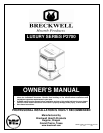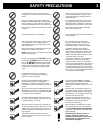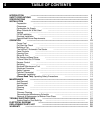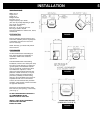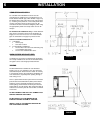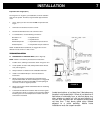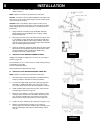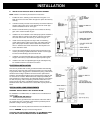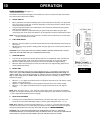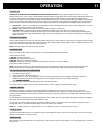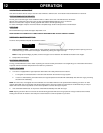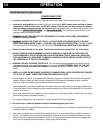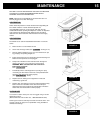
Equivalent Vent Length (EVL)
The longer the run of pipe in your installation, the more restriction
there is in the system. Therefore, larger diameter pipe should be
used.
• Use 4” pipe if you have more than 15 feet of equivalent vent
length.
• Horizontal runs shall not exceed 10’ of EVL.
• Recommended vertical runs to be a minimum of 8’.
• To calculate EVL, use the following conversions:
90º elbow or “T” = 5 equivalent feet
45º elbow = 3 equivalent feet
Horizontal Pipe Run = 1 equivalent foot per actual foot
Vertical Pipe Run = 0.5 equivalent foot per actual foot
NOTE: At altitudes above 3,000 feet, we suggest the use of 4”
diameter vent at an EVL of 7 feet or more.
P2700 INSTALLATION
A. HORIZONTALLY THROUGH WALL (refer to Figure 6)
NOTE: Follow L-Vent chimney manufacturer’s instructions.
1. Position stove, adhering to clearances shown in Figures 1 & 2.
2. Locate position of hole in wall; directly behind stove exhaust
vent (refer to figure 4).
3. Always maintain 3” clearance from combustible materials.
4. Install L-Vent wall thimble per L-Vent manufacturer’s
instructions.
5. Attach enough piping to penetrate and extend at least 6”
beyond exterior walls. An 8-foot vertical pipe run is suggested
where possible to reduce the possibility of smoke spillage in
the event of a loss of negative pressure.
6. Attach cap and seal outside wall thimbles with non-hardening
waterproof mastic.
7. Termination should not be located so that hot exhaust gases
can ignite trees, shrubs, or grasses or be a hazard to children.
Exhaust gases can reach temperatures of 500ºF and cause
serious burns if touched.
Locate terminations: a) not less then 3 feet above any
forced air inlet located within 10 feet; b) not less than 4
feet below or horizontally from, or one foot above, any
door, window or gravity air inlet into any building; c)
not less than two feet from an adjacent building and
not less than 7 feet above grade when located
adjacent to a public walkway. Mobile home
installations must use a spark arrester.
INSTALLATION
7
FIGURE 6



